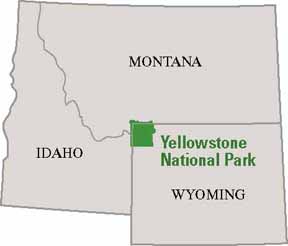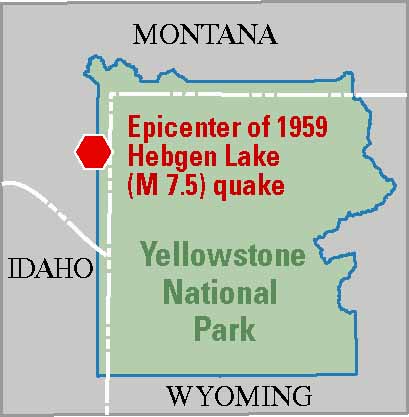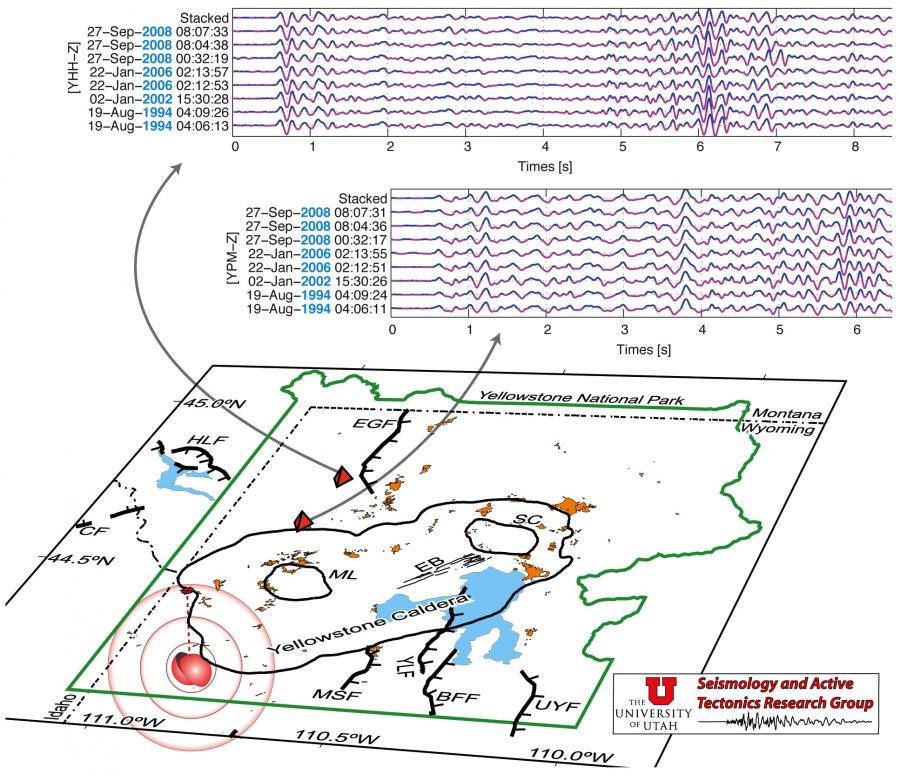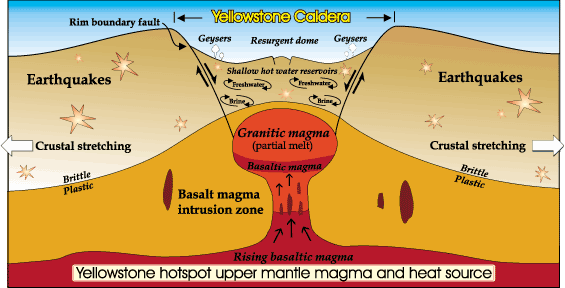Yellowstone Volcano Eruption in 2014? Are Animals Fleeing Park As ‘An Alert’?
This map from the U.S. Geological Service shows the range of the volcanic ash that was deposited after the biggest of the Yellowstone National Park eruptions around 2.1 million years ago. “These eruptions left behind huge volcanic depressions called “calderas” and spread volcanic ash over large parts of North America,” it said. “If another large caldera-forming eruption were to occur at Yellowstone, its effects would be worldwide. Thick ash deposits would bury vast areas of the United States, and injection of huge volumes of volcanic gases into the atmosphere could drastically affect global climate. Fortunately, the Yellowstone volcanic system shows no signs that it is headed toward such an eruption in the near future. In fact, the probability of any such event occurring at Yellowstone within the next few thousand years is exceedingly low.”
A number of bloggers are posting videos that show bison and other animals allegedly leaving Yellowstone National Park, prompting theories that as earthquakes ramp up the seismic activity will set off the Yellowstone supervolcano.
Two of the main bloggers behind the discussion stress that there’s no way to know when the supervolcano will go off but note that the 4.8 magnitude earthquake that hit on March 30 seemed to set off a reaction from the animals, who are moving for a reason.
“Whether I believe this, or whether I don’t believe the story or not, I don’t know. I can tell you this story I saw this morning about the buffaloes running the street … whether or not it’s because of any activity in Yellowstone or not, I don’t know,” said blogger Jay Lee, who posted a story on his site tatoott1009.com.
“But I’ll tell you this, whatever the case may be, that their running away from Yellowstone is an alert of some sort.”
“It also could be from this video, where poachers are killing them, chasing them, abusing them, running them around,” he said. “Could be hundreds of things for them to be running. I wanted you to listen [to the videos] and make up your own mind on what to think. “
A series of smaller quakes have hit the region over the past few weeks, and those quakes have been linked to the recent 5.1 magnitude quake (and aftershocks) that hit in the Los Angeles region.
Tom Lupshu, who describes himself as a “noted Ohio survivalist and search-and-rescue expert,” said on YouTube that nearly one quarter of the northern elk herd at Yellowstone National Park are missing, according to the annual winter count.
“Biologists aren’t sure if there’s been a stunning decline in the herd or if other factors have skewed the tally,” he said. “Current Helium releases at 1000 times above normal. Complete media blackout. Herds of bison running for their lives on the public roadways and they were not being chased or rounded up, the bison were running down the mountain slopes onto roadways running right past a filming crew. They detect something vast and deadly. The Yellowstone Supervolcano is the only thing there that would fit the bill.”
Lupshu said in a later video that scientists say they can’t predict when the Supervolcano will erupt.
“But one thing is for sure. The more the Earthquakes in the region, the more are the chances of the volcano being activated from its dormant state. Last time an earthquake struck in 1980. But the force of nature has acted up once again.”
The supervolcano refers to the huge magma chamber beneath the park, which is in Wyoming.
Supervolcano Far Bigger Than Thought
Researchers recently discovered that the supervolcano is far bigger than previously thought, about 2.5 times.
“We’ve been working there for a long time, and we’ve always thought it would be bigger… but this finding is astounding,” said Bob Smith of the University of Utah.
The findings point to the potentially disastrous consequences if the volcano were ever to blow.
The last major eruption is thought to have happened around 640,000 years ago and sent ash across the entire North America.
Smith said researchers are unsure when the supervolcano would erupt again. Two other eruptions happened, one 2.1 million years ago, and the other 1.3 million years ago, Smith said. One theory is that eruptions happen every 700,000 years ago, but Smith said more data is needed to back that theory up.

Hot springs are evidence of the gigantic supervolcano beneath Yellowstone National Park. (NPS)

(USGS)

(USGS)
The United States Geological Service’s Yellowstone Observatory emphasized in February bulletin that earthquake activity in and around Yellowstone is normal, because between 1,000 and 3,000 typically occur each year.
That includes several each year of magnitudes between three and five.
“Although rising magma and hot-ground-water movement cause some earthquakes, many occur as the result of Basin and Range extension of the western U.S. This tectonic environment has created a series of regional faults that are responsible for large and devastating earthquakes in the Yellowstone region along the Teton and Hebgen Lake Faults. Most recently, a devastating Mw7.3 (Ms 7.5) earthquake in 1959 killed 28 people and caused $11 million in damage (1959 dollars). The majority of the damage occurred as a result of a large landslide that was triggered by the quake,” it said.
“Geologists conclude that large earthquakes like the Hebgen Lake event are unlikely within the Yellowstone Caldera itself, because subsurface temperatures there are high, weakening the bedrock and making it less able to rupture. However, quakes within the caldera can be as large as magnitude 6.5. A quake of about this size that occurred in 1975 near Norris Geyser Basin was felt throughout the region.”
The 4.7 quake on Sunday happened four miles north-northeast of the Norris Geyser Basin. The University of Utah Seismograph Stations termed it “a light earthquake.” It also said that it was part of a series of quakes that includes at least 25 quakes.
The service previously said that research shows earthquakes often happen in clusters in the park, calling them multiplets, or families of repeating earthquakes. Over 15,000 of the more than 33,000 earthquakes that happened between 1984 and 2010 happened in the same location with similar motions from the same seismic sources.

Example of Yellowstone earthquake multiplets (families of repeating earthquakes) that can occur over periods of tens of years from similar seismic sources on the same geological structure. (USGS)
The service also says on its website that “Tere is no evidence that a catastrophic eruption at Yellowstone National Park (YNP) is imminent. Current geologic activity at Yellowstone has remained relatively constant since earth scientists first started monitoring some 30 years ago. Though another caldera-forming eruption is theoretically possible, it is very unlikely to occur in the next thousand or even 10,000 years.
“The most likely activity would be lava flows such as those that occurred after the last major eruption. Such a lava flow would ooze slowly over months and years, allowing plenty of time for park managers to evaluate the situation and protect people. No scientific evidence indicates such a lava flow will occur soon.”
It did admit that the Yellowstone Volcano is still active, and that nothing can be done to prevent an eruption.
The National Park Service says that:
“At Yellowstone and some other volcanoes, some scientists theorize that the earth’s crust fractures and cracks in a concentric or ring-fracture pattern. At some point these cracks reach the magma ‘reservoir,’ release the pressure, and the volcano explodes. The huge amount of material released causes the volcano to collapse into a huge crater—a caldera.”

The Geological Service adds: “The youngest, the Yellowstone Caldera, was formed 640,000 years ago. Since then, about 80 eruptions of rhyolite (thick, sticky lava) and basalt (more-fluid lava) have occurred. The caldera’s interior is largely covered by rhyolites, most erupted in the past 160,000 years. Large hydrothermal (steam)-explosion craters formed in the past 14,000 years are located near Yellowstone Lake and in major geyser basins.
“Any renewed volcanic activity at Yellowstone would most likely take the form of such mainly nonexplosive lava eruptions. An eruption of lava could cause widespread havoc in the park, including fires and the loss of roads and facilities, but more distant areas would probably remain largely unaffected.”
Referring to helium emissions, the agency said that the research into helium conditions that was published earlier this year “has nothing to do with current activity at Yellowstone, and has no implications about volcanic hazards.”
